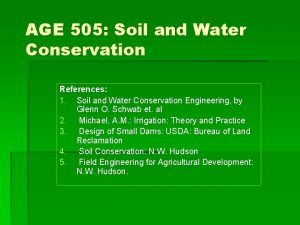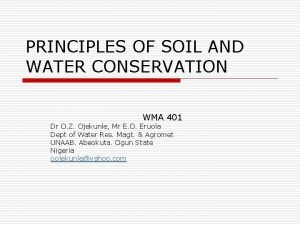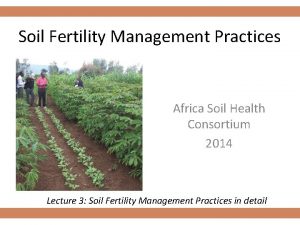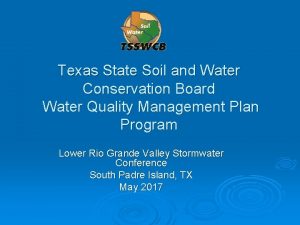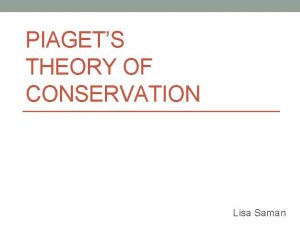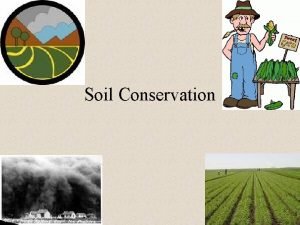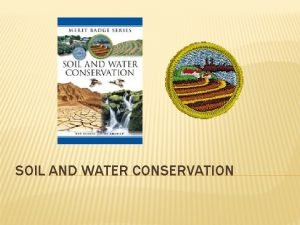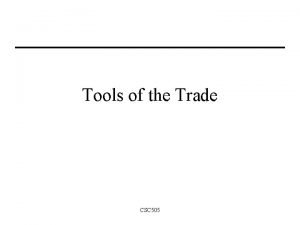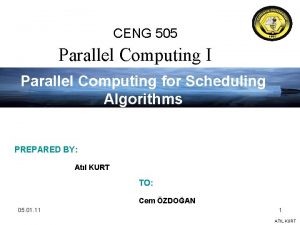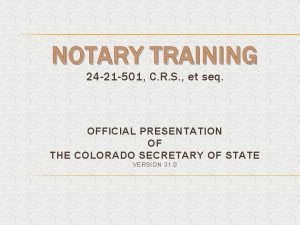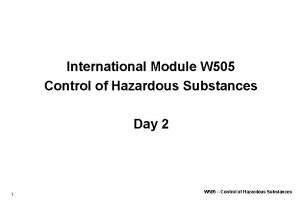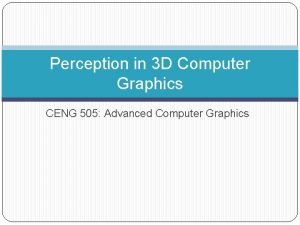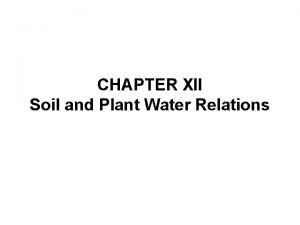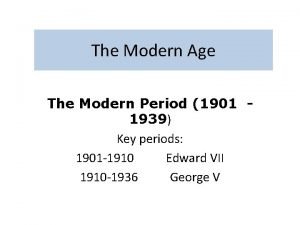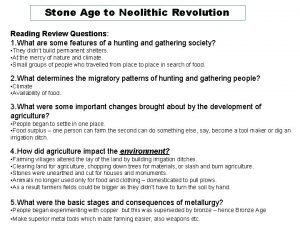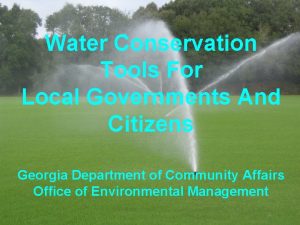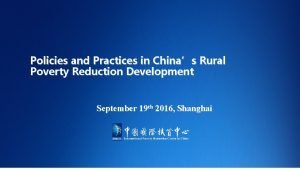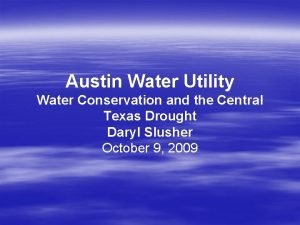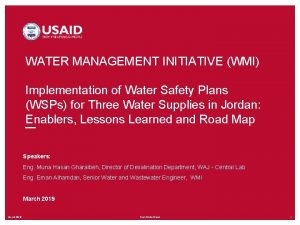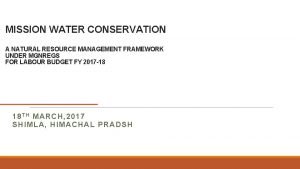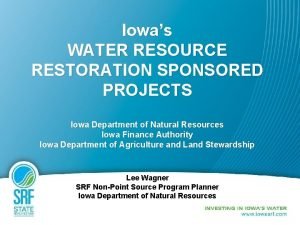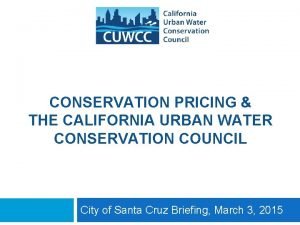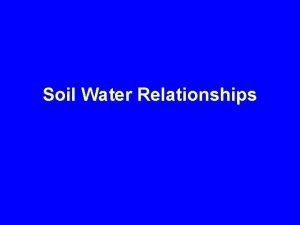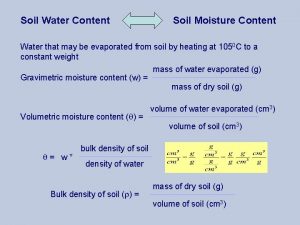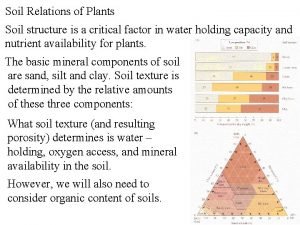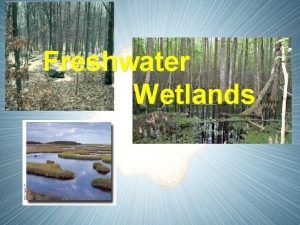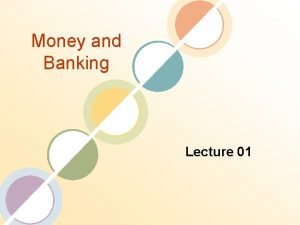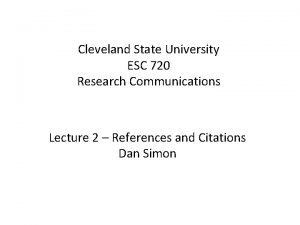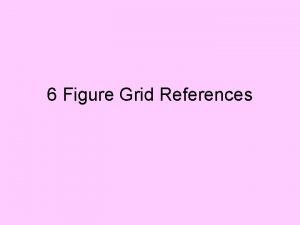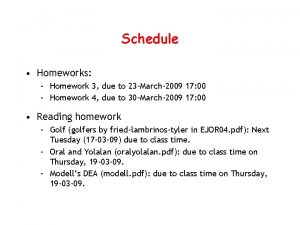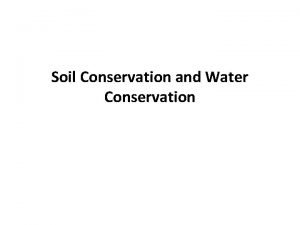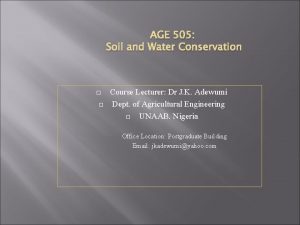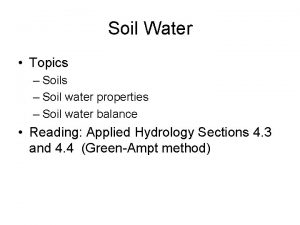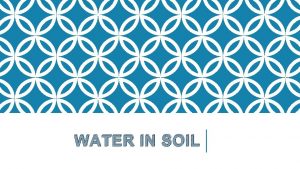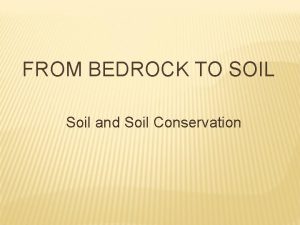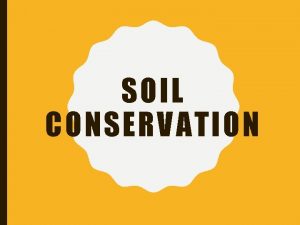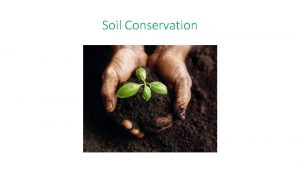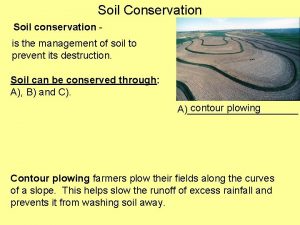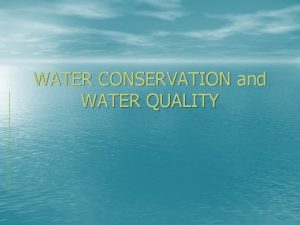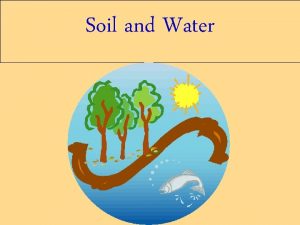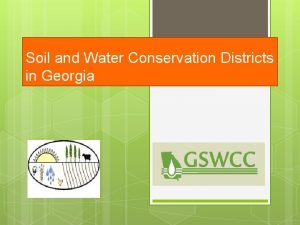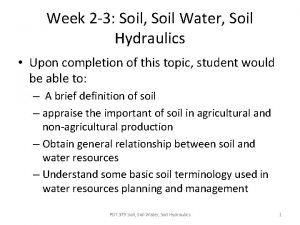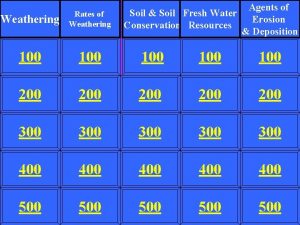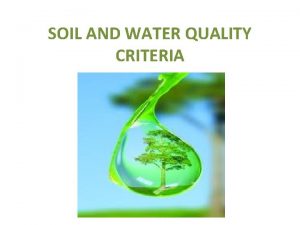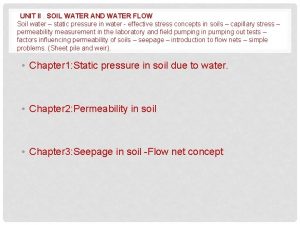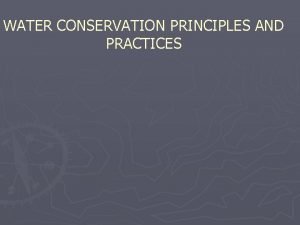AGE 505 Soil and Water Conservation References 1























































- Slides: 55

AGE 505: Soil and Water Conservation References: 1. Soil and Water Conservation Engineering, by Glenn O. Schwab et. al 2. Michael, A. M. : Irrigation: Theory and Practice 3. Design of Small Dams: USDA: Bureau of Land Reclamation 4. Soil Conservation: N. W. Hudson 5. Field Engineering for Agricultural Development: N. W. Hudson.

Introduction § Measures that provide for the management of water and soil § Conservation practices involves the soil, the plant and the climate, each of which is of utmost importance. § The engineering approach to soil and water conservation problems involves the physical integration of soil, water and plants in the design of a co-ordinated water management § The engineering problems involved in soil and water conservation may be divided into the six following phases: Ø Erosion control Ø Drainage Ø Irrigation Ø Flood control Ø Moisture conservation and Ø Water resource development The conservation of these vital resources implies utilization without waste so as to make possible a high level of production which can be continued indefinately.

Types of Erosion Two major types of erosion ü Geological erosion ü Accelerated erosion Geological erosion: includes soil-forming as well as soil eroding processes which maintain the soil in a favorable balance. Accelerated erosion: includes the deterioration and loss of soil as a result of man’s activities. Although, soil removal are recognized in both cases, only accelerated erosion is considered in conservation activities. The forces involved in accelerated erosion are: 1. Attacking forces which remove and transport the soil particles and 2. Resisting forces which retard erosion.

Soil erosion by water Water erosion is the removal of soil from the lands surface by running water including runoff from melted snow and ice. Water erosion is sub-divided into raindrop, sheet, rill, gully and stream channel erosion. Major Factors Affecting Erosion by Water 1. Climate, 2. Soil, 3. Vegetation and 4. Topography Climate: - Precipitation, temperature, wind, humidity and solar radiation Temperature and wind: - evident through their effect on evaporation and transpiration. However, wind also changes raindrop velocities and angle of impact. Humidity and solar radiation are less directly involved since they are associated with temperature. Soil: Physical properties of soil affects the infiltration capacity of the soil. The extend to which it can be dispersed and transported. These properties which influence soil include:

- Soil structure Texture Organic matter Moisture content Density or compactness Chemical and biological characteristics

Vegetation Major effect of vegetation in reducing erosion are: Ø Interception of rainfall Ø Retardation of erosion by decrease of surface velocity Ø Physical restraint of soil movement Ø Improvement of aggregation and porosity of the soil by roots and plants residue Ø Increase biological activities Ø Transpiration – decrease soil moisture resulting in increased storage capacity. These vegetative influences vary with the season, crops, degree of maturity, soil & climate as well as with kind of vegetative materials namely: roots, plant tops, plant residue

Topography Features that influence erosion are: ü degree of slope ü Length of slope ü Size and shape of the watershed üStraight üComplex üConcave üConvex.

Raindrop characteristics § The relationship between erosion and rain fall momentum and energy id determined by raindrop mass, size distribution, shap, velocity and direction. The characterization and measurement of these individual factors demand the utmost ingenuity and precision. The energy equation that has been developed by wischmeier and smith (1958) E=916 +331 logi w and s E=kinetic energy in

§ The resistance of a soil to erosion depends on many factors and so to measure erodibility numerically an assessment has to be made of each factor. § -nature of soil slope of land kind of crop. Erosivity-is the aggressiveness or potential ability of rain to cause erosion. Erodibility-is the vulnerability or susceptibility of the soil to erosion.

Factors influencing erodibility § Two groups of factors. § 1. physical features of the soil. i. e what kind of soil § 2. treatment of the soil. i. e what is done with it. the part concerned with treatment has much the greater effect. And is also most difficult to access. i. e average increase in soil loss per unit increase in E I. These is a great deal of experimental evidence to suggest a link between erosive power and the mass and velocity of falling drops. Ellison(1944).

§ Bisal(1960) suggests in a similar lab. G =k D V 1. 4 S=weight of soil splashed in grams k=constant for the soil type D=drop diameter in mm v=impact velocity m/s. In both these studies the combination of power of drop velocity and drop mass are not very different from combining mass and velocity into the parameter kinetic energy.

§ Rose (1960) challenges the above assumption that results such as these proves that splash erosion is dependent only on the k. E. of natural or artificial rain, and shows that if such a relationship exist it is equally valid , though different relationship will exist between erosion and momentum or any other function of mass and velocity. since mass occurs in the same form in the formula for both momentum and energy, it is necessary to vary velocity in order to resolve the problem of whether energy or momentum is the better index of erosivity. Conclusively-it has been shown that for natural rain the relationships between intensity and either momentum or kinetic energy are equally close and of the same pattern.

Estimating erosivity from rainfall data § The EIzo index. R=EIzo This is the product of kinetic energy of the stem and the 30 -mints intensity. This latter term requires some explanation. -It is the greatest average intensity experienced in any 30 -min period during the stem. -This amount could be doubled to set the same dimension as intensity, i. e. inches/hour, mm/hr. The measure of erosivity is described as the EIzo index. it can be computed for individuals storms, and the storm values can be summed over periods of time to give weekly, monthly, or annual values of erosivity.

Application of an index of erosivity § The ability to access numerically the erosive power of rainfall has two main applications. In practical soil conservation it helps : 1. to improve the design of conservation works. 2. in research, it helps to increase our knowledge and understanding of erosion.

Soil detachment and transportation § The process of soil erosion involves soil detachment and soil transportation. Generally, soil detachability increases as the size of the soil particles increase and soil transportability increases with a decrease in particle size. § detachment causes damage because: 1. The soil particles are removed from the soil mass and thus easily transported. 2. The five materials and plant nutrients are removed. 3. Seeds may be separated and washed out of the soil.

Sheet erosion Uniform removal of soil in thin layers from sloping landresulting from sheet or overland flow occurring in thin layers. minute rilling takes place almost simultaneously with the first detachment and movement of soil particles. the constant meander and change of position of these microscopic rills.

Rill erosion Removal of soil by water from small but well defined channels or streamlets where there is a concentration of overland flow. Obviously, rill erosion occurs when these channels have become sufficiently large and stable to be readily seen.

Gully erosion produces channels larger then rills. These Channels carry water during and immediately after rain.

Principles of gully erosion The rate of gully erosion depends primarily § on the runoff producing characteristics of the watershed § the drainage area § soil characteristics § the alignment § size and shape of gully § the slope in the channel.

Gully development processes 1. Water fall erosion at the gully head. 2. Channel erosion caused by water flowing through the gully or by raindrop splash on unprotected soil. 3. Alternate freezing and thawing of exposed soil banks. 4. Slides or mass movement of soil in the gully.

Four stages of gully development Stage 1 Channel erosion by down ward scour of the topsoil. This stage normally proceeds slowly where the topsoil is fairly resistant to erosion Stage 2: upstream movement of the gully head and enlargement of the gully in width and depth. The gully cuts to the horizon and the weak parent material is rapidly removed. stage 3: Healing stage with vegetation to grow in the channel. Stage 4: Stabilization of the gully. The channel reaches a stable gradient, gully walls reach and stable slope and vegetation begins to grow in sufficient abundance to anchor the soil and permit development of new topsoil

Sediment movement in channels Sediments in streams is transported by : 1. Suspension 2. Siltation 3. Bad load movement. Suspension: suspended sediment is that which remains in suspension in flowing water for a considerable period of time without contact with the stream bed. saltation: sediment movement by saltation occurs where the particle skip or bounce along the stream bed. In comparison to total sediment transported , saltation is considered relatively unimportant.

Sediment movement in channels Bed load: Bed load is sediment that moves in almost continous contact with the stream bed being rolled or pushed along the bottom by the force of the water. Mavis (1935), developed an equation for unigranular materials ranging in diameter from 0. 35 to 0. 57 millimeters and specifically from 1. 83 to 2. 64.

Universal soil loss equation Smith and wisehmeier (1957, 1962) developed an equation for estimating the average annual soil loss. A=RKLSCP Am=2. 24 RKLSCP metric unit. A=average soil loss +/a tons/acre. R=rainfall erosivity index. k=soil erodibity index. L=slope length factor S=slope gradient factor. C=cropping management factor. P=conservation particle factor. Ls= topographic factor evaluated.

Personal management soil loss under standard management. This varies normally from 0 -1. P: values depends on law and slope it also depends on the type of farming system we have. Example A: Determine soil loss from the following condition. K=0. 1 ton/acre S=10% L=400 C=0. 15 Field is to be confoured p=0. 6

A= RKLSCP. =0. 1 400 x 0. 18 x 0. 6 x R B=Also determine soil loss from the following condition. K=0. 1 ton/acre L=400 S=80% C=0. 18 P=0. 6 if the soil loss is 6. 7 ton/acre what is the max slope length and corresponding tar ale spacing to reduce soil loss to 3 tons/acre.

we want max Ls value to reduce soil lose to 3 tons/acre. Ls=2 x 3/67 =0. 9 Therefore =70’ max slope length V. I /70 = 8/100 V. I = 5. 6’ practical application of using universal soil loss equation. 1. To predict erosion. 2. To select crop management practices. 3. To predict erosion from catch crops.

Land use § § § Very suitable land classification. Fairly suitable according to suitability factor. Not suitable a particular crop. § § § Land capability classification. The type of soil. Depth of soil. Texture. Land slope. Past erosion on the land.

Soil erosion by wind Wind erosion is more frequent when the mean annual rainfall is low. Major factor that affects soil erosion by wind are: 1. 2. 3. climate Soil characteristics Vegetation climate: § Rainfall affects soil moisture. § Temperature humidity. § Wind.

Wind characteristics that affects soil erosion. § Duration. § Turbulent of the wind (velocity). For any given soil condition the amount of soil which will be blown depends on two factors: § The wind velocity. § The roughness of the soil surface. Soil: factors soil texture. density of soil particle and density of soil mass. organic matter content. soil moisture.

Vegetation: height of vegetation. density of cover. types of vegetation. seasonal distribution of vegetation. Types of soil movement by wind 1. Suspension. 2. Saltation. 3. Surface. creep

These three distinct types of movement usually simultaneously. suspension particle were carried about 1 m above on the surface. ( i. e. above 3 ft) saltation This is caused by the pressure of the wind on the soil particle and its collision with other particles. surface creep This movement is mostly pronounced on the surface of the soil.

Mechanics of wind erosion process may also be broken into the three simple but distinct phases: 1. Initiation of movement. 2. Transportation. 3. Deposition. 1. Initiation of movement as a result of turbulence and wind velocity. Fluid threshold velocity The main velocity required to produce soil movement by direct action of wind.

Impact threshold velocity the minimum velocity required to initiate movement from the impact of soil particle carried in saltation. 2. Transportation the quantity of soil moved is influenced by the particle size gradation of particle, wind velocity and distance across the erodindg area. The quantity of soil moved varies as the cube of the excess wind velocity over and above the constant threshold velocity directly as the square of the particles diameter and increases with the gradation of the soil.

Six shape bulk density consider them as groups. we use equivalent diameter to test the level of compa: Standard particle is any spheres with bulk density of 2. 65. this has certain erodibility. Soil particle this also has a diameter shape and bulk density. Equivalent diameter is the diameter of standard particle that has an erodibility which is equal to the erodibility of soil particle. Ed = bxd/2. 65 diameter of soil particle.

Q x ( V-Vc ) Vc=threshold velocity. V=wind velocity when V = Vc =no movement. Deposition: deposition of sediment occurs when the gravitational force is greater then the force holding the particles in the air. this generally occurs when there is a decrease in wind velocity.

Soil physical factors played also a major roll. Mechanics of wind. soil moisture condition. effect of organic matter. i. e. various climate factors.

Control of wind erosion. Two major types of wind erosion control consist of 1. Those measures that reduce surface wind velocity(vegetation tilling soil after rain) 2. Those that affect soil characteristics such as: conservation of moisture and tillage. contouring (teracing) generally vegetative measure tillage practices mechanical methods.

Damages done by wind 1. 2. 3. 4. crop damage particularly at seeding stage. expose of land use. The change in soil texture Health. Damage to properties (road and building).


Contouring, stip cropping and tillage. § One of the base engineering practices in conservation farming is the adjustment of tillage and crop management from uphill to downhill to contour opertions contouring, strip cropping and terracing are important conservation practices for controlling water erosion. Surface roughness, ridges, depression and related physical characteristics influenceing depression storage of precipitation.

contouring When plow furrows, planter furrows, and cultivation furrows run uphill and downhill then forms natural channels in which runoff accumulates. As the slope of these furrows increases the velocity of the water movement increases with resulting destructive erosion. In contouring tillage operations are carried out as nearly as practicals on the contour. a guide line is laid out for eash plow land the back furrows or dead furrows are plowed on these lines.

§ Disadvantage: is used alone on steeper slopes or under conditions of high rainfall intensity and soil erodibility, these is an increased hazard of gullying because row breaks may release the stored water. § Strip cropping: strip cropping consist of a series of alternate strips of various types of crops laid out so that all tillage and crop management practices are performed across the slope or on the contour.

The three general types of strip cropping are: 1. Contour strip cropping with layout and tillage held closely with the exact contour and with the crops following a definite rotational sequence. 2. Field strip cropping with strips of a uniform width placed across the general slope. 3. Buffer strip cropping with strips of some grass or legume crop laid out between contour strips of crops in the regular rotations, then may be even or irregular in width.

when contour strip cropping is combined with contour tillage or teuracing, it effectively divides the length of the slope, checks the velocity of runoff, filters out soil from the runoff water and facilitates absorbtion of rain. strip cropping layout The three general methods of laying out strip cropping are: 1. Both edges of the strips on the contour 2. One or more strips of uniform width laid out from a key or base contour line. 3. Alternate uniform width and variable width correction

methods of layout vary with topography and with each individual’s preference. Tillage practices: tillage is the mechanical manipulation of the soil to provide soil conditions suited to the growth of crops, the control of weeds and for the maintenance of infiltration capacity and aeration. Indiscriminate tillage, tillage without thought of topography , soil climate and crop conditions will lead to soil deterioration through erosion and loss of structure.

TERRACING This is a method of erosion control accomplished by constructing broad chennels across the slope of rolling land. Reasons for constructing terace If surface runoff is allowed to flow unimpeded down the slope of arable land these is a danger that its volume or velocity or both may build up to the points where I is not only carries the soil dislodged by the splash erosion but also has a scouring action of its own. various names given to this techniques are: terraces (U. S. A). ridge or bund (common wealth countries).

functions § To decrease the length of the hillside slope , thereby reducing sheet and rill erosion. § Preventing formation of gullies and retaining runoff in areas of inadequate precipitation. § In dry regions such conservation of moisture is important in the control of wind erosion Types of terraces ( terrace classification) a. two major types of terraces are: 1. bench terrace. 2. broad base terrace.

§ Bench terrace reduces land slope § Broad base terrace removes or retain water on sloping land. broad base terrace has its primary functions classified as: graded level. graded terrace primary purpose of thus type is to remove excess water in such a way as to minimize erosion. level terrace primary purpose of thus type of terrace is moisture conservation erosion control is a secondary objective.

soil profile. the embankment for thus type of terrace is usually constructed of soil taken from both sides of the ridge. This is necessary to obtain a sufficiently high embankment to prevent over topping and breaking through by the entrapped runoff water. TERRACE DESIGN The design of terrace system involves the proper spacing and location of terraces, the design of channel with adequate capacity and development of a farmable x-section.

Terrace spacing is expressed as the vertical distance between the channels of successive terraces. The vertical distace is commonly known as the V. I = a= b= s= as + b = V. I =0. 3( as + b) constant for geographical location. constant for soil erodibility. average land slope above the terrace in %

Terrace grades § Terrace grades : refers back apart from the fact that it must provide good drainage , it must also remove runoff at non erosive velocity. § Terrance length: size and slope of the field outlet possibilities, rate of runoff as affected by rainfall and soil in filtration and chemical capacity are factors that influence terrace length.

Planning the terrace system § a. selection of outlets: or disposal area: vegetated outlets ( preferable) The design runoff for the outlet is determined by summation of the runoff from individual terrace. outlets are of many types such as : natural draws. constructed channels. sod flumes. permanent pasture or meadow. road ditches.

§ b. Terrace location : factors that influence terrace location includes; land slope, soil conditions. § Lay out procedure : determine the predominant slope above the terrace. obtain a suitable vertical interval. stakes the Wight channel is terrace construction : a variety of equipment is available for terrace construction which necessitated a classification of four machine according to thuds of moving soil.

Factors affecting rate of construction Equipment soil moisture crop and crop residues degree and regularity of land soil tilth gullies and other obstruction terrace length terrace cross-section experience and skill of operator
 Water conservation references
Water conservation references Objectives of water conservation
Objectives of water conservation Africa soil health consortium
Africa soil health consortium Texas state soil and water conservation board
Texas state soil and water conservation board Water and water and water water
Water and water and water water Piaget nature vs nurture
Piaget nature vs nurture Centration
Centration Stone age, bronze age iron age timeline
Stone age, bronze age iron age timeline Iron age bronze age stone age timeline
Iron age bronze age stone age timeline Soil conservation and domestic allotment act
Soil conservation and domestic allotment act Soil conservation and domestic allotment act
Soil conservation and domestic allotment act Soil conservation and domestic allotment act
Soil conservation and domestic allotment act Hepscd
Hepscd Soil conservation
Soil conservation Soil conservation project
Soil conservation project 505 design
505 design Cantique 505
Cantique 505 Identify the following hand wheel color cod
Identify the following hand wheel color cod Tstf-505
Tstf-505 Objetivo de la nia 505
Objetivo de la nia 505 505
505 505 congress st
505 congress st Rulona section 24-21-505(4)
Rulona section 24-21-505(4) 505
505 Ceng 505
Ceng 505 Especialitat 505
Especialitat 505 Living soil vs dead soil
Living soil vs dead soil What are the four spheres of the earth
What are the four spheres of the earth Soil and water relationship
Soil and water relationship Victorian age and modern age
Victorian age and modern age Difference between stone age and modern age
Difference between stone age and modern age Victorian period in english literature
Victorian period in english literature Water conservation tools
Water conservation tools Piaget's water conservation task
Piaget's water conservation task Water conservation project
Water conservation project Water conservation in hotel industry
Water conservation in hotel industry Austin water conservation
Austin water conservation Water conservation project
Water conservation project Mission water conservation
Mission water conservation Water conservation project
Water conservation project California urban water conservation council
California urban water conservation council How is soil made
How is soil made Water retention in soil
Water retention in soil Available water definition
Available water definition Water content of soil
Water content of soil Soil texture water holding capacity
Soil texture water holding capacity Freshwater wetlands purify water by
Freshwater wetlands purify water by Chapter 1 science and the environment
Chapter 1 science and the environment Explain how water erosion by groundwater can form a cave.
Explain how water erosion by groundwater can form a cave. Darcy law
Darcy law Five core principles of money and banking
Five core principles of money and banking The difference between reference and bibliography
The difference between reference and bibliography Difference between bibliography and references
Difference between bibliography and references Contextual criticism art
Contextual criticism art 6 figure grid reference
6 figure grid reference (acv-s03) homework - addresses and references
(acv-s03) homework - addresses and references
